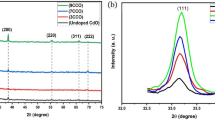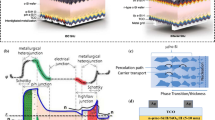Abstract
A thermally conductive film can be used to laterally conduct heat along the surface of glass windows, toward its edges where a heat sink could be located, thereby reducing temperature differential between the inside and outside surfaces of the window and thus lowering cross-sectional conductive heat transfer. This technique can offer optimized thermal energy management to modern buildings without the weight and cost of double- or triple-glazed window panels. In this work, a thermally conductive film was developed using carbon dots with inherently high thermal conductivity. Nitrogen atoms were then added to the carbon dots structure to intensify high-frequency phonon that would result in higher lateral thermal conductivity. The nitrogen-decorated carbon dots (NCDs) were prepared by a simple hydrothermal synthesis of citric acid with the addition of ethylenediamine as the N source. The NCDs were added to a cellulose-based solution and drop-casted onto FTO glass resulting in a transparent, laterally thermally conductive film, that also blocks ultraviolet (UV) and high-intensity blue light radiation. The visible-light transmission of the NCDs’ film was found to be up to 65%, comparable to the commercial solar films. The lateral thermal conductivity of the NCDs’ film increases with increasing N content up to an optimum level, suggesting the role of N to “concentrate’ the high-frequency phonons responsible for effective lateral thermal conductivity of the films.







Similar content being viewed by others

References
Perera DW, Skeie N-O (2017) Comparison of space heating energy consumption of residential buildings based on traditional and model-based techniques. Buildings. https://doi.org/10.3390/buildings7020027
Pérez-Lombard L, Ortiz J, Pout C (2008) A review on buildings energy consumption information. Energy Build 40:394–398
Ürge-Vorsatz D, Cabeza LF, Serrano S, Barreneche C, Petrichenko K (2015) Heating and cooling energy trends and drivers in buildings. Renew Sustain Energy Rev 41:85–98
Goei R, Ong AJ, Hao TJ, Yi LJ, Kuang LS, Mandler D, Magdassi S, Yoong Tok AI (2021) Novel Nd–Mo co-doped SnO2/α-WO3 electrochromic materials (ECs) for enhanced smart window performance. Ceram Int 47:9
Goei R, Ong AJ, Tan JH, Loke JY, Lua SK, Mandler D, Magdassi S, Yoong Tok AIY (2021) Nd–Nb Co-doped SnO2/α-WO3 electrochromic materials: enhanced stability and switching properties. ACS Omega 6(40):26251. https://doi.org/10.1021/acsomega.1c03260
Jelle BP (2013) Solar radiation glazing factors for window panes, glass structures and electrochromic windows in buildings—measurement and calculation. Sol Energy Mater Sol Cells 116:291–323
Kumar S, Sheeja R, Jospher AJS, Sai Krishnan G, Chandrasekar, AroulRaj A (2021) Energy-saving potential of a passive cooling system for thermal energy management of a residential building in Jaipur City, India. Mater Today Proceed 43:1471–1477
Mariano-Hernández D, Hernández-Callejo L, Zorita-Lamadrid A, Duque-Pérez O, Santos García F (2021) A review of strategies for building energy management system: model predictive control, demand side management, optimization, and fault detect & diagnosis. J Build Eng 33:101692
Sadineni SB, Madala S, Boehm RF (2011) Passive building energy savings: a review of building envelope components. Renew Sustain Energy Rev 15:3617–3631
Vrachopoulos MG, Koukou MK, Filos G, Moraitis C (2013) Investigation of heat transfer in a triple-glazing type window at Greek climate conditions, Central European. J Eng 3:750–763
Wang S, Ma Z (2008) Supervisory and optimal control of building HVAC systems: a review. HVAC&R Res 14:3–32
Balandin AA, Ghosh S, Bao W, Calizo I, Teweldebrhan D, Miao F, Lau CN (2008) Superior thermal conductivity of single-layer graphene. Nano Lett 8:902–907
Pop E, Mann D, Wang Q, Goodson K, Dai H (2006) Thermal conductance of an individual single-wall carbon nanotube above room temperature. Nano Lett 6:96–100
Seol JH, Jo I, Moore AL, Lindsay L, Aitken ZH, Pettes MT, Li X, Yao Z, Huang R, Broido D, Mingo N, Ruoff RS, Shi L (2010) Two-dimensional phonon transport in supported graphene. Science 328:213
Song N-J, Chen C-M, Lu C, Liu Z, Kong Q-Q, Cai R (2014) Thermally reduced graphene oxide films as flexible lateral heat spreaders. J Mater Chem A 2:16563–16568
Kumar P, Shahzad F, Yu S, Hong SM, Kim Y-H, Koo CM (2015) Large-area reduced graphene oxide thin film with excellent thermal conductivity and electromagnetic interference shielding effectiveness. Carbon 94:494–500
Suriani AB, Muqoyyanah, Mohamed A, Alfarisa S, Mamat MH, Ahmad MK, Birowosuto MD, Soga T (2020) Synthesis, transfer and application of graphene as a transparent conductive film: a review. Bull Mater Sci 43:310
Frank BP, Sigmon LR, Deline AR, Lankone RS, Gallagher MJ, Zhi B, Haynes CL, Fairbrother DH (2020) Photochemical transformations of carbon dots in aqueous environments. Environ Sci Technol 54:4160–4170
Wang B, Song H, Qu X, Chang J, Yang B, Lu S (2021) Carbon dots as a new class of nanomedicines: opportunities and challenges. Coord Chem Rev 442:214010
Xu D, Lin Q, Chang H-T (2020) Recent advances and sensing applications of carbon dots. Small Methods 4:1900387
Long C, Jiang Z, Shangguan J, Qing T, Zhang P, Feng B (2021) Applications of carbon dots in environmental pollution control: a review. Chem Eng J 406:126848
Liu J, Li R, Yang B (2020) Carbon dots: a new type of carbon-based nanomaterial with wide applications. ACS Cent Sci 6:2179–2195
Mintz KJ, Bartoli M, Rovere M, Zhou Y, Hettiarachchi SD, Paudyal S, Chen J, Domena JB, Liyanage PY, Sampson R, Khadka D, Pandey RR, Huang S, Chusuei CC, Tagliaferro A, Leblanc RM (2021) A deep investigation into the structure of carbon dots. Carbon 173:433–447
Su W, Wu H, Xu H, Zhang Y, Li Y, Li X, Fan L (2020) Carbon dots: a booming material for biomedical applications. Mater Chem Front 4:821–836
Liu Y, Huang H, Cao W, Mao B, Liu Y, Kang Z (2020) Advances in carbon dots: from the perspective of traditional quantum dots. Mater Chem Front 4:1586–1613
Barman BK, Sele Handegård Ø, Hashimoto A, Nagao T (2021) Carbon dot/cellulose-based transparent films for efficient UV and high-energy blue light screening. ACS Sustain Chem Eng 9:9879–9890
Mirsaeidi AM, Yousefi F (2021) Viscosity, thermal conductivity and density of carbon quantum dots nanofluids: an experimental investigation and development of new correlation function and ANN modeling. J Therm Anal Calorim 143:351–361
Gamal El-Shamy A (2021) The role of nitrogen-carbon dots (NC) nano-particles in enhancing thermoelectric power functions of PEDOT:PSS/Te nano-composite films. Chem Eng J 417:129212
Cheng S, Ye T, Mao H, Wu Y, Jiang W, Ban C, Yin Y, Liu J, Xiu F, Huang W (2020) Electrostatically assembled carbon dots/boron nitride nanosheet hybrid nanostructures for thermal quenching-resistant white phosphors. Nanoscale 12:524–529
Yang B, Li D, Qi L, Li T, Yang P (2019) Thermal properties of triangle nitrogen-doped graphene nanoribbons. Phys Lett A 383:1306–1311
Lin Y-C, Lin C-Y, Chiu P-W (2010) Controllable graphene N-doping with ammonia plasma. Appl Phys Lett 96:133110
Zhang C, Fu L, Liu N, Liu M, Wang Y, Liu Z (2011) Synthesis of nitrogen-doped graphene using embedded carbon and nitrogen sources. Adv Mater 23:1020–1024
Inagaki M, Toyoda M, Soneda Y, Morishita T (2018) Nitrogen-doped carbon materials. Carbon 132:104–140
Wang H, Maiyalagan T, Wang X (2012) Review on recent progress in nitrogen-doped graphene: synthesis, characterization, and its potential applications. ACS Catal 2:781–794
Nguyen TD, Yeo LP, Si Yang K, Chiew Kei T, Wang Z, Mandler D, Magdassi S, Tok AIY (2020) Fabrication and characterization of graphene quantum dots thin film for reducing cross-sectional heat transfer through smart window. Mater Res Bull 127:110861
Chen D, Wu W, Yuan Y, Zhou Y, Wan Z, Huang P (2016) Intense multi-state visible absorption and full-color luminescence of nitrogen-doped carbon quantum dots for blue-light-excitable solid-state-lighting. J Mater Chem C 4:9027–9035
Miao X, Qu D, Yang D, Nie B, Zhao Y, Fan H, Sun Z (2018) Synthesis of carbon dots with multiple color emission by controlled graphitization and surface functionalization. Adv Mater 30:1704740
Wang L, Zhu S-J, Wang H-Y, Qu S-N, Zhang Y-L, Zhang J-H, Chen Q-D, Xu H-L, Han W, Yang B, Sun H-B (2014) Common origin of green luminescence in carbon nanodots and graphene quantum dots. ACS Nano 8:2541–2547
Sarkar S, Sudolská M, Dubecký M, Reckmeier CJ, Rogach AL, Zbořil R, Otyepka M (2016) Graphitic nitrogen doping in carbon dots causes red-shifted absorption. J Phys Chem C 120:1303–1308
Yuan F, Li S, Fan Z, Meng X, Fan L, Yang S (2016) Shining carbon dots: Synthesis and biomedical and optoelectronic applications. Nano Today 11:565–586
Swartz ET, Pohl RO (1989) Thermal boundary resistance. Rev Mod Phys 61:605–668
Jaćimovski SK, Bukurov M, Šetrajčić JP, Raković DI (2015) Phonon thermal conductivity of graphene. Superlattices Microstruct 88:330–337
Nika DL, Pokatilov EP, Askerov AS, Balandin AA (2009) Phonon thermal conduction in graphene: role of Umklapp and edge roughness scattering. Phys Rev B 79:155413
Acknowledgements
This research is supported by grants from the National Research Foundation, Prime Minister’s Office, Singapore under its Campus of Research Excellence and Technological Enterprise (CREATE) Program.
Author information
Authors and Affiliations
Corresponding author
Ethics declarations
Conflict of interest
The authors declare that there is no competing financial interest.
Additional information
Publisher's Note
Springer Nature remains neutral with regard to jurisdictional claims in published maps and institutional affiliations.
Rights and permissions
About this article
Cite this article
Goei, R., Tan, F.T.F., Ong, A.J. et al. Development of nitrogen-decorated carbon dots (NCDs) thermally conductive film for windows application. Carbon Lett. 32, 1065–1072 (2022). https://doi.org/10.1007/s42823-022-00337-7
Received:
Revised:
Accepted:
Published:
Issue Date:
DOI: https://doi.org/10.1007/s42823-022-00337-7



